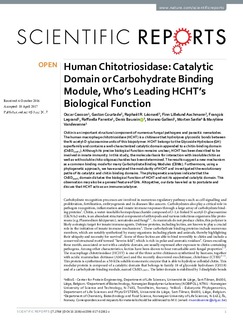| dc.contributor.author | Crasson, Oscar | |
| dc.contributor.author | Courtade, Gaston | |
| dc.contributor.author | Leonard, Raphael R | |
| dc.contributor.author | Aachmann, Finn Lillelund | |
| dc.contributor.author | Legrand, Francois | |
| dc.contributor.author | Parente, Raffaella | |
| dc.contributor.author | Baurain, Denis | |
| dc.contributor.author | Galleni, Moreno | |
| dc.contributor.author | Sørlie, Morten | |
| dc.contributor.author | Vandevenne, Marylene | |
| dc.date.accessioned | 2017-10-30T11:31:36Z | |
| dc.date.available | 2017-10-30T11:31:36Z | |
| dc.date.created | 2017-06-06T09:39:50Z | |
| dc.date.issued | 2017 | |
| dc.identifier.issn | 2045-2322 | |
| dc.identifier.uri | http://hdl.handle.net/11250/2462830 | |
| dc.description.abstract | Chitin is an important structural component of numerous fungal pathogens and parasitic nematodes. The human macrophage chitotriosidase (HCHT) is a chitinase that hydrolyses glycosidic bonds between the N-acetyl-D-glucosamine units of this biopolymer. HCHT belongs to the Glycoside Hydrolase (GH) superfamily and contains a well-characterized catalytic domain appended to a chitin-binding domain (ChBDCHIT1). Although its precise biological function remains unclear, HCHT has been described to be involved in innate immunity. In this study, the molecular basis for interaction with insoluble chitin as well as with soluble chito-oligosaccharides has been determined. The results suggest a new mechanism as a common binding mode for many Carbohydrate Binding Modules (CBMs). Furthermore, using a phylogenetic approach, we have analysed the modularity of HCHT and investigated the evolutionary paths of its catalytic and chitin binding domains. The phylogenetic analyses indicate that the ChBDCHIT1 domain dictates the biological function of HCHT and not its appended catalytic domain. This observation may also be a general feature of GHs. Altogether, our data have led us to postulate and discuss that HCHT acts as an immune catalyser. | nb_NO |
| dc.language.iso | eng | nb_NO |
| dc.publisher | Nature Publishing Group | nb_NO |
| dc.rights | Navngivelse 4.0 Internasjonal | * |
| dc.rights.uri | http://creativecommons.org/licenses/by/4.0/deed.no | * |
| dc.title | Human Chitotriosidase: Catalytic Domain or Carbohydrate Binding Module, Who’s Leading HCHT’s Biological Function | nb_NO |
| dc.type | Journal article | nb_NO |
| dc.type | Peer reviewed | nb_NO |
| dc.description.version | publishedVersion | nb_NO |
| dc.source.volume | 7 | nb_NO |
| dc.source.journal | Scientific Reports | nb_NO |
| dc.source.issue | 1 | nb_NO |
| dc.identifier.doi | 10.1038/s41598-017-02382-z | |
| dc.identifier.cristin | 1474142 | |
| dc.relation.project | Norges forskningsråd: 226244 | nb_NO |
| dc.description.localcode | © 2017 The Authors. Published by Nature Publishing Group. This is an open access article licensed under a Creative Commons Attribution 4.0 International License | nb_NO |
| cristin.unitcode | 194,66,15,0 | |
| cristin.unitname | Institutt for bioteknologi og matvitenskap | |
| cristin.ispublished | true | |
| cristin.fulltext | original | |
| cristin.qualitycode | 1 | |

